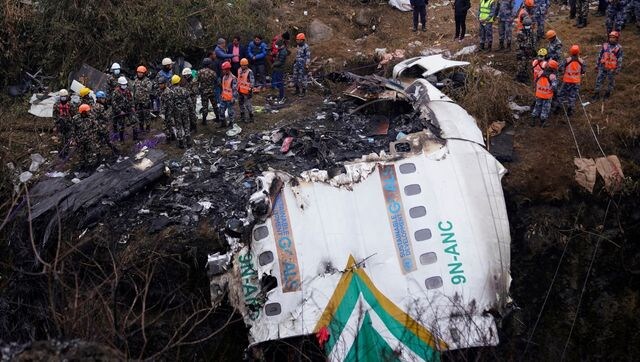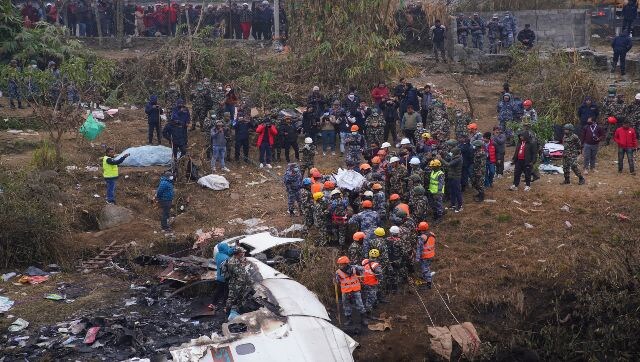Nepal Air Tragedy: Pilot couple die in similar crashes 16 years apart, flying for the same Yeti Airlines
Anju Khatiwada, co-pilot on ill-fated Nepal's Yeti Airlines ATR-72, had followed the footstep of her pilot husband who also died in a plane crash in 2006

Rescuers scour the crash site in the wreckage of a passenger plane in Pokhara, Nepal. AP.
Kathmandu: Anju Khatiwada, the co-pilot on ill-fated Nepal’s Yeti Airlines ATR-72, had followed the footstep of her pilot husband who also died in a plane crash in 2006.
The Nepal’s airplane with 72, including five Indians, onboard crashed on Sunday morning in Pokhara. Bodies of 69 people have been recovered and the hunt for missing three people was underway at the time of filing this report.
Khatiwada, 44, is among the four missing but she is feared to be dead.
A report by news agency Reuters quoted Yeti Airlines spokesman Sudarshan Bartaula saying Khatiwada joined Nepal’s Yeti Airlines in 2010, four years after her husband Deepak Pokhrel died in a small passenger plane crash that he was flying for Yeti Airlines in Jumla.
“Dipak Pokhrel, died in 2006 in a crash of a Twin Otter plane of Yeti Airlines in Jumla. She got her pilot training with the money she got from the insurance after her husband’s death,” Bartaula said.
Khatiwada had more than 6,400 hours of flying time to her credit. On Sunday, she was flying the plane with instructor pilot Kamal KC as per the standard procedure of the airlines, Yeti Airlines official, who knew Khatiwada said.
Also Read: Watch: The last moments of the ill-fated Yeti aircraft in Nepal crash
The official also said, “Khatiwada was always ready to take up any duty and had flown to Pokhara earlier.”
Previously, Khatiwada had flown the popular tourist route from the Nepal’s capital Kathmandu to the country’s second-largest city Pokhara.
The body of the captain of the flight, Kamal KC, who had more than 21,900 hours of flight time, has been recovered and identified.
What caused the crash will be ascertained from the cockpit voice recorder and flight data recorder from the aircraft which were recovered on Monday.
The Yeti Airlines flight crashed mere 10 to 20 seconds before landing at the newly inaugurated Pokhara International Airport. As per reports, the flight fell on the banks of Seti river between the new and old airport.
Reuters report said since 2000, around 350 people have died in plane or helicopter crashes in Nepal where sudden weather changes can make for hazardous conditions.
Read all the Latest News, Trending News, Cricket News, Bollywood News,
India News and Entertainment News here. Follow us on Facebook, Twitter and Instagram.
also read

Hoping against hope, Nepal plane crash rescuers search for the last four missing persons
Nepalese rescuers resumed their search on Monday for the four persons still missing after a plane with 72 people, including five Indians, crashed into a river gorge while landing at the newly-opened airport in Pokhara, killing at least 68 people onboard.

Nepal: Pokhara airport where plane crash happened built with China's support, inaugurated two weeks ago
Last year, former Chinese foreign minister Wang Yi handed over the Pokhara Regional International Airport to the then Nepal Prime Minister Sher Bahadur Deuba, during a courtesy call held at Baluwatar

Over 27 plane crashes in 30 years: Why Nepal's mountains aren't the only reason for its poor air safety record
Sunday's air crash involving Yeti Airlines is yet another black mark on Nepal’s air safety record. While the topography and wild weather make it difficult to fly in the Himalayan kingdom, the use of dated technology and lack of reforms in the aviation sector are also to blame for the tragedies
